-
Posts
12437 -
Joined
-
Last visited
-
Days Won
554
Content Type
Profiles
Forums
Events
Everything posted by Fiery
-
I'm not sure if this can be resolved, since the audio issues are caused by the Dell SMI BIOS layer that AIDA64 has to handle to read Dell SMI sensor values. We'll try to come up with an alternative access method, although I'm not sure if there's one exist at all. Do you have a Dell software that can read those sensor values without audio issues?
-
The requested feature will be implemented in the next AIDA64 beta update due in a few days from now Regards, Fiery
-
SensorPanel and LCD layouts are stored in the file called AIDA64.INI in the AIDA64 installation folder. Make sure to backup that file after you've built your LCD layout. BTW, by using the built-in AIDA64 automatic internet update feature, both your settings (AIDA64.INI) and your entered product key (license) are retained after an upgrade.
-
As far as I know, neither SDKs (Logitech LED and Razer Chroma) allow multiple applications to concurrently handle the keyboard LED matrix. So when a software takes over the keyboard, the other ones cannot handle it anymore and has to wait for the application to quit. I'm not sure if Logitech or Razer would like to allow concurrent access at all, but it may worth a try asking them about this.
- 64 replies
-
- BlackWidow Chroma
- LED
-
(and 8 more)
Tagged with:
-
According to our knowledge, no, not yet
-
That file is used to read the system BIOS and video BIOS content when no administrator privileges are provided to AIDA64.EXE. Since it's a 16-bit DOS executable, it is not used under any 64-bit Windows installations.
-

New LCD device support: Samsung SPF Digital Photo Frames
Fiery replied to Fiery's topic in Hardware monitoring
Such measures shouldn't be necessary. The update does nothing else than download a ZIP package and extract it to the AIDA64 installation folder, by overwriting the old files. AIDA64.INI is never included in update packages, and the update process doesn't reconfigure AIDA64 either. -

New LCD device support: Samsung SPF Digital Photo Frames
Fiery replied to Fiery's topic in Hardware monitoring
What did happen? What didn't work? I'm sorry to hear that, but please note that all you have to back up is the file AIDA64.INI that you can find in the AIDA64 installation folder. That files includes all settings and all LCD + SensorPanel layouts. I'd recommend you to do a regular backup of that file, along with your Documents folder and other important files and folders. -
That could happen when you use DPI scaling. We haven't yet found a way to fix that issue Regards, Fiery
-
Please upgrade to the latest beta version of AIDA64 Extreme available at: http://www.aida64.com/downloads/latesta64xebeta After upgrading to this new version, make sure to restart Windows to finalize the upgrade. Let me know if it helps. Thanks, Fiery
-
We've implemented support for Corsair K65 RGB, K70 RGB and K95 RGB keyboards in the following new AIDA64 Extreme beta update: http://www.aida64.com/downloads/latesta64xebeta Please note that Corsair keyboards require a bit more complicated handling, e.g. separate code path for international keyboard layouts. We have very limited documentation on the issue, so right now the RGB LED module only supports the US layout. In theory it would work with any layouts, but there may be issues with QWERTZ vs. QWERTY vs. AZERTY key indexes. If you find a bug or glitch about the layout, please let us know exactly which keyboard with which international layout do you have, and we'll fix it up.
- 64 replies
-
- BlackWidow Chroma
- LED
-
(and 8 more)
Tagged with:
-

fixed: AIDA64 and Skylake (BCLK OCing)
Fiery replied to Noshuru's topic in Benchmarking, system performance
Apparently that was actually 2 separate issues about Skylake BCLK overclocking, but we've already fixed up both issues in the following new AIDA64 beta update: http://www.aida64.com/downloads/latesta64xebeta Thank you for your help -

fixed: AIDA64 and Skylake (BCLK OCing)
Fiery replied to Noshuru's topic in Benchmarking, system performance
Thank you. I've just sent you a private message. -

fixed: AIDA64 and Skylake (BCLK OCing)
Fiery replied to Noshuru's topic in Benchmarking, system performance
Thank you, that looks very interesting, and also quite odd. Please also post a screen shot of the CPU Tweakings panel, at 23x200 setting. Right-click on the bottom status bar of AIDA64 main window --> CPU Debug --> CPU Tweakings. -

fixed: Aqua computer Aquaero water level gone
Fiery replied to Dschidi's topic in Hardware monitoring
Thank you for the feedback -

fixed: AIDA64 and Skylake (BCLK OCing)
Fiery replied to Noshuru's topic in Benchmarking, system performance
There's definitely an issue about using high BCLK setting on MSI and Asus motherboards. It's not about the benchmarks working off, they do work well actually. The benchmark results however are scaled by the CPU core clock value, and that's where there's a glitch. We have to check the CPU registers to see where does AIDA64 go wrong about calculating the CPU core clock. Please right-click on the bottom status bar of AIDA64 main window --> CPU Debug --> CPUID & MSR Dump. Copy-paste the full results into this topic. If it's possible, please do that for both clock settings of 46x100 and 23x200. -
Here's the first AIDA64 beta with the new RGB LED module working: http://www.aida64.com/downloads/latesta64xebeta You can enable it from AIDA64 / main menu / File / Preferences / Hardware Monitoring / RGB LED. The new module is designed to be used on per-key RGB LED keyboards. It currently supports Razer BlackWidow Chroma and Logitech G910 keyboards only. We're planning to implement support for Corsair RGB keyboards in the next AIDA64 beta update. For Razer keyboards the currently beta state Razer Chroma SDK has to be installed. IMPORTANT: In order for the beta Chroma SDK to work properly, Synapse has to be closed! Hopefully the stable build of Chroma SDK will eliminate this limitation. For Logitech G910 the latest version of Logitech Gaming Software has to be installed. It's also recommended to update the keyboard's firmware to the latest version. We've basically implemented 3 out of the 4 proposed ideas, and a variant of idea #3. So, you can use the RGB LED module in 4 ways right now: 1) Single Key: You can display a temperature, voltage, fan speed or other monitored value on a single key of the keyboard, by altering the colour of the key based on the actual value. You can set the limits in the same way that you set the limits for bars on the SensorPanel or LCD. 2) Row of Keys: You can use a row of keys, like Function Keys or Numbers to make a bar that changes its length and colour as well, based on the actual value of the monitored item. Due to different localized keyboard layouts, we had to define a larger set of rows than the usual 5 rows of Function Keys, Numbers, QWERTY..., ASDFG... and ZXCVB... 3) 2 Digits: By using the Functions Keys and Numbers rows, you can display a value using 2 digits. The first digit will be displayed on the Functions Keys row, and the second digit will be displayed on the Numbers row. However, in order to enable quicker readout, AIDA64 will try to display both digits on the Numbers row whenever it's possible. 12, 35, 79 and other numbers will be displayed that way, but 54, 82, 97 (etc) will be displayed by using both the Function Keys and Numbers row. There's also a setting to let you divide down the measured values by a factor. So, e.g. by using a divisor of 100, you can display fan RPM by having just 2 digits. 1820RPM will then be displayed as "18". 4) 3 Digits: A variant of the 2 Digits solution, by also using the Numeric Keypad (NumPad) for the 3rd digit. Just as with 2 Digits, this feature will also try to display as much digits as possible by using only the Function Keys and Numbers rows. Please let us know what you think. By using this feature you will quickly realize that it is more basic and more limited than other monitoring modules of AIDA64, but keep in mind that this is only a start. If there's a considerable interest in this feature, we'll improve and extend it to make it more practical and also more fun to use it
- 64 replies
-
- BlackWidow Chroma
- LED
-
(and 8 more)
Tagged with:
-

New LCD device support: Samsung SPF Digital Photo Frames
Fiery replied to Fiery's topic in Hardware monitoring
Sounds great, thank you It could be because in your case we're using an exact multiply of 64KB. Let's see how it goes with other frames -

New LCD device support: Samsung SPF Digital Photo Frames
Fiery replied to Fiery's topic in Hardware monitoring
Yes, we've just added a new, hidden option that you can use to tweak the JPEG limiter by yourself, and so try multiple values without us having to alter the main AIDA64 code base. Download the new AIDA64 beta from: http://www.aida64.com/downloads/latesta64xebeta Go to AIDA64 / main menu / File / Preferences, and simply press the OK button. Close AIDA64, go to AIDA64 installation folder, and open the AIDA64.INI file in a text editor (e.g. Notepad). Find the following line in there: HWMonSPLCDJPEGLimit=0 And change it to a value below 500, e.g.: HWMonSPLCDJPEGLimit=490 That will effectively limit the JPEG frame size to 490KB. I think the actual limit will always be an exact multiply of 64KB, but it's just a theory that has to be verified. If my hunch is right, you will still experience issues at 490KB, 480KB, 470KB, etc, and it will only work reliably when you set it to 448KB (7x64KB). Please let me know how it goes. What sort of hardware monitor value type are you thinking of? The colour of a Simple Sensor Item label? -

fixed: Aqua computer Aquaero water level gone
Fiery replied to Dschidi's topic in Hardware monitoring
We've just rolled out the mentioned new AIDA64 beta update: http://www.aida64.com/downloads/latesta64xebeta -
AIDA64 main window can remember its size if you enable that in AIDA64 / main menu / File / Preferences / Layout. The Preferences panel will also remember its size. We've just tried, and importing SensorPanel layouts into a RemoteSensor layout works fine, including all graphs. If you have difficulties importing your SensorPanel layout, then please open your .sensorpanel file in Notepad, find the entry that is imported incorrectly, and copy-paste that line into this topic. Or, you can attach the whole file to your post if you want.
- 103 replies
-
- RemoteSensor
- Safari
-
(and 8 more)
Tagged with:
-
Yes. Previously, swap space incorrectly included the physical memory, and we've added up physical memory and swap space to form virtual memory, which again was incorrect. We had to remove virtual memory and rename swap space to virtual memory to make it right.
-
You're good to go. Go to the next page in the AIDA64 Preferences called LCD Items, and start building your own LCD layout. As for resizing, the whole window should fit in the Windows Desktop area, even when it is resized automatically to fit the RemoteSensor LCD layout builder. When you use RemoteSensor, Logitech Arx or other high-resolution LCD, the Preferences window will have to be adjusted to a minimum width and height to make sure the layout editor fits properly. If you then resize the window, the window size will of course be remembered.
- 103 replies
-
- RemoteSensor
- Safari
-
(and 8 more)
Tagged with:

